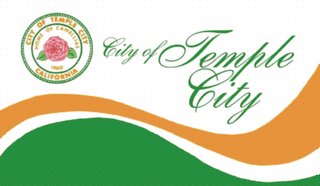
I'm writing a monthly column for the local paper. Here's the first entry. Regular DD readers will see some overlap from earlier entries. Also, Las Tunas is the major East/West street in Temple City. Here goes:
UNCOMMON SENSE
With Glenn Layne
I was in Israel the last week of January and saw first hand the “wall”, or as Israelis call it, “The Security Fence.” For most of its length, the Fence is just that—a fence with a security perimeter. Under Israeli law, the fence cannot be electrified. (I sure didn’t know that, did you?) The reason is that they believe that would be cruel, and too much like the sufferings suffered by Jewish people during the Holocaust. The same principle is applied to the fence that has for years separated Israel and Syria (the Golan Heights area). Instead, the fence is designed to be an intimidating barrier, physically and psychologically.
In some areas, it is a real wall. For example, there are stretches of the N-5 freeway that run parallel to the wall, so it is a real wall so prevent weapons fire into the very modern highway (it reminded me of the new section of the 210 opened a few years ago).
Only once did our group come up close and personal to the Fence/Wall: that was at the Jerusalem/Bethlehem crossing. To cross over, our bus parked on the Israeli side and we went through a serpentine maze, designed to slow down and thwart a potential attacker. All our items were x-rayed, much as at an airport.
The Israeli side was immaculate; the Arab side of the wall was plastered with make-shift protest murals. “To exist is to resist,” said one, in English. Another depicted an Israeli lion attacking an Arabic dove. His motive? In Hebrew, it said shekelim: money. (For a photo of the Arab side of the wall, see http://durabledata.blogspot.com/2006/02/dd-is-back.html.) The anti-Jewish nature of the signs were all the more striking since we’d spent a good portion of the morning at Yad Vashem, the Israeli memorial to the Holocaust.
On that side, we were met by an Arab guide. Our group was small, so he’d arraigned for two vans to meet us. He was a chatty fellow, and our group was bold enough to ask political questions. What did he think of the recent Hamas victory in the Palestinian elections? “No good, no good,” he said. He was from the dwindling Palestinian Arab Christian minority of Bethlehem.
Life had been hard for everyone in the “Territories” (the term preferred by the Israelis). When the latest round of the Intifada brook out in 2000, tourism practically died in Israel. Tourist dependant towns like Bethlehem were hit hard. Add to that the fact that radicals actually seized control of the Church of the Nativity and held it for several weeks and the increased strife between Christian and Muslim Arabs, the last five and a half years had been hard. Many Christian Arabs were giving up: leaving for America and Europe.
I was in Israel last in 1999, and I can testify to the fact that overall, Bethlehem looked worn down and beaten up compared to the bustling town I recalled. The wall had imposed hardship on all Palestinians. The economy all over the territories is suffering; the security fence meant that thousands of Palestinians who used to work in Israel proper can no longer get clearances to get in. The electoral victory of Hamas will not make matters better. Life is very hard for the average Palestinian family.
But I have to ask myself, if it was my kid whose life was threatened when they went to a pizza place, how would I think? The reality is we would put a wall up the middle of Las Tunas Avenue if it meant saving lives of our kids.
The Israelis are glad for the wall. Terrorist attacks are down 95% since the bulk of the fence went up. (It is still not quite complete, and locations can be moved based on appeals to the Israeli Supreme Court.)
Now what does this all have to do with thinks locally? One member of our group mused aloud, “We need one of these along the Mexican border.”
It’s clear the border enforcement American style is rather porous. If we had to deal with Latin America suicide bombers hitting San Diego and El Paso, we might as well build a wall.
Here in Temple City, we are undergoing an ethnic transformation of tidal proportions. In the 1940s, Temple City was populated by Los Angeles commuters and newcomers to the area, including (sometime I’ll write about the fact that Star Trek was invented by Temple City newcomer from Texas named Gene Roddenberry). This wave of settlement was overwhelmingly white.
Whatever you think about a security fence along the Mexican border, the reality is that the greater San Gabriel Valley has become the destination of choice for thousands of Asian immigrants. Thank God, it doesn’t have the menace of radicals with suicide bombs.
In one sense, it doesn’t matter what you or I think. The future’s coming whether we’re ready for it or not. No wall can or will be built. The only question is whether we deal wisely with the transformation or not. I know this is a high priority at the church I serve. It needs to be priority one all across the community. Walls will not do. Bridges are our priority.
Written February 25, 2006.
No comments:
Post a Comment